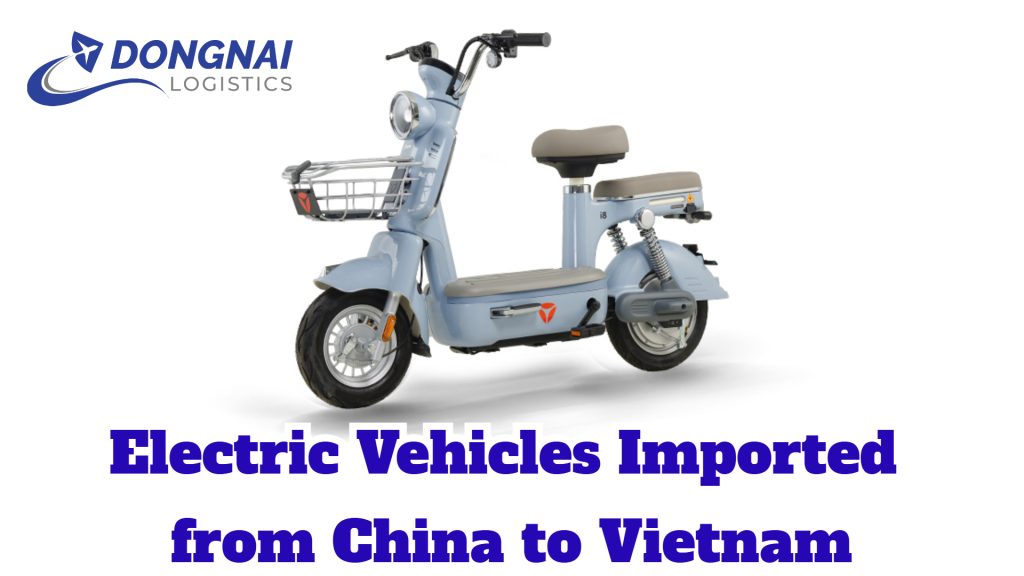Electric Vehicles Imported from China to Vietnam: Market Trends and Growth Opportunities
Overview of the Chinese Electric Vehicles Market in Vietnam
Electric vehicles (EVs) are gaining significant traction worldwide, and Vietnam is no exception. With growing environmental awareness and rising fuel prices, more consumers are shifting towards sustainable transportation solutions. Among the various EV suppliers, China has emerged as a dominant player, offering high-quality electric cars at competitive prices. The import of Chinese EVs to Vietnam is increasing rapidly, with well-known brands such as BYD, NIO, and Xpeng making their presence felt in the market. Favorable tax policies, coupled with the expansion of charging infrastructure, have further fueled the demand for these vehicles in Vietnam.

Why Are Chinese Electric Vehicles Gaining Popularity in Vietnam?
1. Competitive Pricing
One of the primary reasons Chinese EVs are making a strong impact in Vietnam is their affordability. Compared to EVs imported from Europe, the United States, or Japan, Chinese EVs come at significantly lower prices. This cost advantage is primarily due to China’s efficient mass production processes, government incentives for the EV industry, and economies of scale. As a result, Vietnamese consumers looking for budget-friendly yet technologically advanced vehicles find Chinese EVs an attractive option.
2. Advanced Technology and Innovation
China has invested heavily in EV technology, making significant advancements in battery efficiency, autonomous driving features, and smart connectivity. Many Chinese electric cars come equipped with:
- High-capacity lithium-ion batteries that provide extended driving ranges.
- AI-driven autonomous driving features for enhanced safety and convenience.
- Large touchscreen infotainment systems with integrated smart assistants.
- Fast-charging capabilities, allowing vehicles to charge up to 80% in under an hour.
These technological advancements make Chinese EVs a compelling choice for Vietnamese consumers who seek modern, feature-rich vehicles.
3. Wide Range of Models and Customization Options
Chinese EV manufacturers offer a diverse range of models, catering to different market segments. Whether consumers are looking for compact city cars, mid-sized sedans, or luxury SUVs, Chinese brands provide a variety of options. Popular models include:
- Small city EVs: Ideal for urban commuting with compact designs and energy-efficient performance.
- Electric sedans: Offering a balance between affordability and advanced features for daily use.
- High-end electric SUVs: Providing luxury, high performance, and extended driving ranges for long-distance travel.
This variety ensures that both individual car buyers and fleet operators can find suitable options to meet their needs.

Challenges of Importing Chinese EVs to Vietnam
Despite the growing popularity of Chinese electric vehicles in Vietnam, there are still some challenges that need to be addressed.
1. Quality and Brand Perception Issues
While Chinese EVs have made great strides in terms of technology and reliability, some Vietnamese consumers remain skeptical about their durability. Many still prefer established European, Japanese, or South Korean brands due to their reputation for long-term reliability. To overcome this challenge, Chinese EV manufacturers must focus on building trust through:
- Stronger warranty policies.
- Improved after-sales services.
- Demonstrating consistent product quality through independent safety tests and certifications.
2. Charging Infrastructure Limitations
One of the biggest barriers to widespread EV adoption in Vietnam is the lack of an extensive charging station network. While major cities like Hanoi and Ho Chi Minh City are seeing increased investment in EV infrastructure, rural areas still face significant limitations. The success of Chinese EVs in Vietnam will depend on continued investment in fast-charging networks and home-charging solutions.
3. Import Taxes and Regulatory Policies
Although Vietnam has implemented some tax incentives for electric vehicles, imported EVs still face tariffs and other fees. To increase competitiveness, there needs to be:
- Further reductions in import duties for EVs.
- Incentives for local assembly or manufacturing partnerships between Chinese brands and Vietnamese companies.
- Government policies encouraging businesses to invest in EV infrastructure.
Future Outlook: The Growth Potential of Chinese Electric Vehicles in Vietnam
1. Government Policies Supporting Electric Vehicles Adoption
Vietnam has set ambitious goals for reducing carbon emissions and promoting sustainable transportation. Government initiatives such as tax breaks, reduced registration fees, and investment in green energy solutions are expected to drive EV adoption further. If Vietnam continues to support electric vehicle imports through policy adjustments, the market for Chinese EVs will likely experience exponential growth.
2. Battery Technology and Energy Efficiency Improvements
One of the key advancements in the EV industry is the continuous improvement of battery technology. Chinese EV manufacturers are investing heavily in next-generation batteries that offer:
- Longer driving ranges per charge.
- Faster charging times.
- Increased lifespan, reducing long-term ownership costs.
These advancements will make EVs more practical and appealing to Vietnamese consumers, further solidifying the role of Chinese EVs in the market.
3. Expansion of the Charging Network
Several Vietnamese companies and foreign investors are actively working on expanding the EV charging infrastructure. As the number of charging stations grows, range anxiety among potential EV buyers will decrease, making electric vehicles a more viable option for long-distance travel.
4. Potential for Local Production and Assembly
To reduce costs and improve supply chain efficiency, Chinese EV brands may explore partnerships with Vietnamese companies to set up local assembly plants. This move would:
- Lower vehicle prices by avoiding certain import tariffs.
- Create jobs and boost the local economy.
- Improve the availability of spare parts and maintenance services.
Conclusion: Will Chinese Electric Vehicles Dominate the Vietnamese Market?
The influx of Chinese EVs into Vietnam marks a significant shift in the country’s automotive industry. With their affordability, advanced technology, and growing variety, Chinese EVs are well-positioned to become a major player in the market. However, overcoming challenges related to brand perception, charging infrastructure, and regulatory policies will be crucial.
As Vietnam continues to move towards greener transportation solutions, Chinese EV manufacturers have a golden opportunity to establish a strong presence. By focusing on quality assurance, expanding after-sales support, and working alongside policymakers to enhance EV infrastructure, Chinese electric vehicles could soon become the preferred choice for Vietnamese consumers.
Read more:
Vận tải biển: Xương sống của chuỗi cung ứng toàn cầu
Vải Vận Chuyển Từ Đồng Nai Sang Phần Lan Bằng Đường Biển
Vận chuyển hàng hóa từ Đồng Nai đi Phú Quốc
Chuyển phát nhanh từ Quảng Ninh đến Đồng Nai chất lượng, uy tín, giá cạnh tranh

